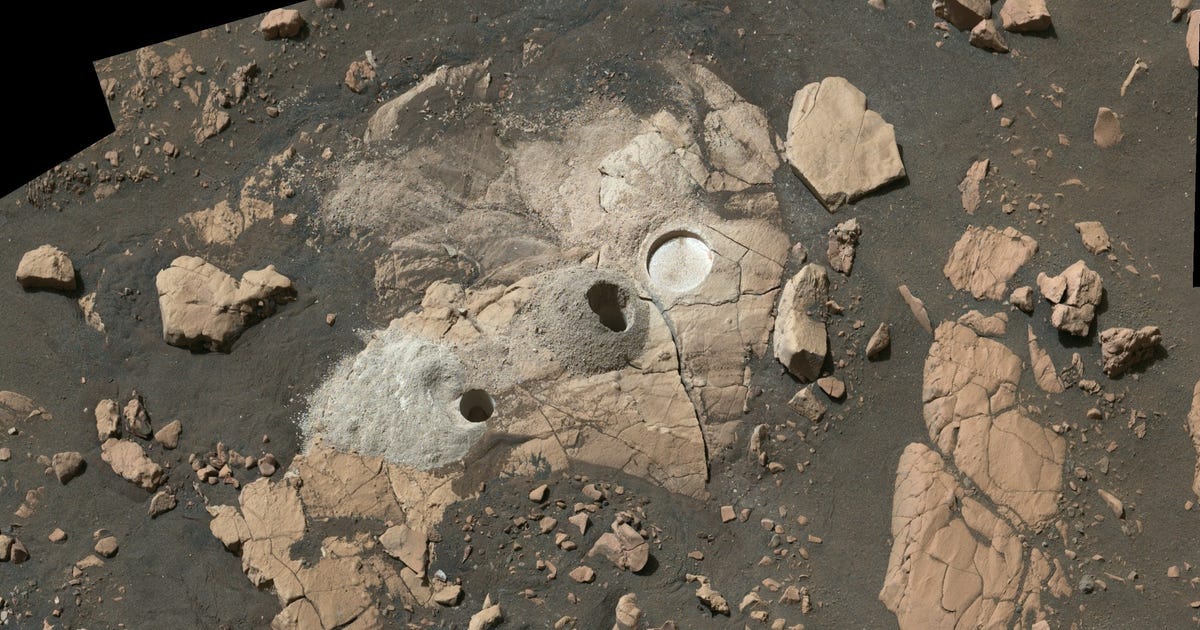NASA’s Mars Perseverance Rover Finds Intriguing Organic Matter in Rock
This story is part of Welcome to Mars, our series exploring the red planet.
In just a year and a half on Mars, NASA’s Perseverance rover has absolutely rocked its mission. The agency held a briefing Thursday to discuss highlights from the science mission so far, and it was a celebration of rock samples and the discovery of organic matter.
Organic molecules in Wildcat Ridge
A rock named Wildcat Ridge, located in an ancient river delta region of Jezero Crater, was one of the stars of the show. Percy successfully collected two samples from the mudstone rock. Wildcat Ridge is particularly exciting because the organic molecules (called aromatics) found in it are considered a potential biosignature, which NASA describes as a substance or structure that could be evidence of past life but may also have been produced without the presence of life.
The rover team emphasized that finding organic matter doesn’t mean it’s found evidence of ancient life. Organic molecules have been spotted on Mars before, by the Curiosity rover in Gale Crater and also by Perseverance, which found carbon-containing molecules earlier in the mission.
Perseverance collected two core samples from Wildcat Ridge and also abraded a round patch to inspect the rock with its Sherloc instrument.
NASA, JPL-Caltech, ASU, MSSS
The rover’s Sherloc instrument investigated the rock. (Sherloc stands for Scanning Habitable Environments with Raman & Luminescence for Organics & Chemicals.) “In its analysis of Wildcat Ridge, the Sherloc instrument registered the most abundant organic detections on the mission to date,” NASA said.
Scientists are seeing familiar signs in the analysis of Wildcat Ridge. “In the distant past, the sand, mud and salts that now make up the Wildcat Ridge sample were deposited under conditions where life could potentially have thrived,” said Perseverance project scientist Ken Farley in a statement. “The fact the organic matter was found in such a sedimentary rock — known for preserving fossils of ancient life here on Earth — is important.”
Perseverance isn’t equipped to find definitive evidence of ancient microbial life on the red planet. “The reality is the burden of proof for establishing life on another planet is very, very high,” said Farley during the press conference. For that, we need to examine Mars rocks up close and in person in Earth labs.
Sample drop
Percy currently has 12 rock samples on board, including the Wildcat Ridge pieces and samples from another sedimentary delta rock called Skinner Ridge. It also collected igneous rock samples earlier in the mission that point to the impact of long-ago volcanic action in the crater.
NASA is so happy with the diversity of samples collected that it’s looking into dropping some of the filled tubes off on the surface soon in preparation for the future Mars Sample Return (MSR) campaign. MSR is an ambitious plan to send a lander to Mars, pick up Percy’s samples, rocket them off the surface and bring them back to Earth for close study. The mission is under development. If all goes as planned, those rocks could be here by 2033.
The complexity and importance of MSR means NASA and its partners are working out ways to ensure the samples can be collected. There’s hope Perseverance will still be operating in good condition by the time the MSR lander arrives, and will be able to meet it and personally deliver samples. Leaving some samples on the ground this early in the mission at a cache site in the crater will give MSR another opportunity to get the precious rocks on board.
Percy has been collecting paired samples. For example, it could keep one Wildcat Ridge tube on board and drop the other on the ground. “That we are weeks from deploying Perseverance’s fascinating samples and mere years from bringing them to Earth so scientists can study them in exquisite detail is truly phenomenal,” said NASA JPL Director Laurie Leshin. “We will learn so much.”
What’s next for Percy
As thrilling as the delta has been, the rover team is looking ahead at future adventures beyond it. Perseverance could wander up the crater rim, with the team eyeing several possible paths for the climb. Its companion Ingenuity helicopter is in good health and expected to take to the air again.
NASA chose Jezero Crater for exploration because of its fascinating history of water and how the rocks there might preserve evidence of ancient life, if it existed during more habitable times on Mars. Sherloc scientist Sunanda Sharma likened the mission to a treasure hunt for organic life on another planet, saying the samples with aromatics are a clue. The Martian mystery is only just beginning to unfold.
For all the latest world News Click Here

